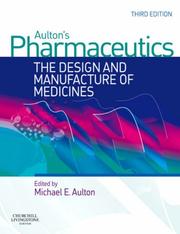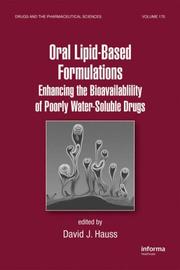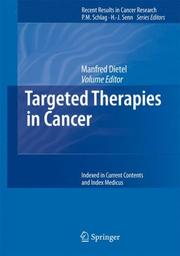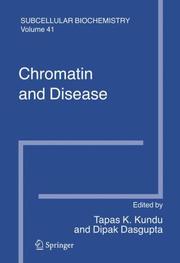| Listing 1 - 7 of 7 |
Sort by
|

ISBN: 9780443101083 9780443101076 0443101086 0443101078 Year: 2007 Publisher: Edinburgh ; New York : Churchill Livingstone,
Abstract | Keywords | Export | Availability | Bookmark
 Loading...
Loading...Choose an application
- Reference Manager
- EndNote
- RefWorks (Direct export to RefWorks)
Dosage Forms. --- Biopharmaceutics. --- Drug Design. --- Drugs --- Médicaments --- Dosage forms. --- Design. --- Formes pharmaceutiques --- Conception --- Drug Modeling --- Design, Drug --- Designs, Drug --- Drug Designs --- Drug Modelings --- Modeling, Drug --- Modelings, Drug --- Chemistry, Pharmaceutical --- Dosage Form --- Form, Dosage --- Forms, Dosage --- Drug Administration Routes --- Drug Delivery Systems --- Médicaments --- Biopharmaceutics --- Dosage Forms --- Drug Design --- Pharmaceutics --- Pharmaceutic --- Compounding, Drug --- Dosage forms of drugs --- Drug compounding --- Pharmaceutical compounding --- Pharmaceutical dosage forms --- Drug delivery systems --- Drug design --- Pharmaceutical design --- Drug development --- Design --- Dosage forms
Book
ISBN: 9782224029463 2224029462 Year: 2007 Publisher: Paris : Maloine,
Abstract | Keywords | Export | Availability | Bookmark
 Loading...
Loading...Choose an application
- Reference Manager
- EndNote
- RefWorks (Direct export to RefWorks)

ISBN: 9780824729455 0824729455 9780429133695 Year: 2007 Volume: v. 170 Publisher: New York : Informa Healthcare,
Abstract | Keywords | Export | Availability | Bookmark
 Loading...
Loading...Choose an application
- Reference Manager
- EndNote
- RefWorks (Direct export to RefWorks)
Biological Availability. --- Solubility --- Dosage Forms. --- Drug Administration Routes. --- Drug Delivery Systems --- Lipids --- Drugs --- Solutions (Pharmacy) --- Lipides --- Médicaments --- Solutions (Pharmacie) --- drug effects. --- methods. --- Therapeutic use. --- Solubility. --- Dosage forms. --- Emploi en thérapeutique --- Solubilité --- Formes pharmaceutiques --- Bioavailability. --- Solutions. --- Solutions (Pharmacy). --- Administration. --- Drug effects. --- Methods.

ISBN: 1280937327 9786610937325 3540460918 354046090X 3642432433 Year: 2007 Publisher: Berlin ; [London] : Springer,
Abstract | Keywords | Export | Availability | Bookmark
 Loading...
Loading...Choose an application
- Reference Manager
- EndNote
- RefWorks (Direct export to RefWorks)
From its introduction, oncological chemotherapy has been encumbered by its poor selectivity because most antiproliferative drugs are toxic not only to tumor cells but also to important populations of the body’s non-neoplastic cells. The resultant problems with unwanted side effects are compounded by difficulties in predicting the desired effectivity of chemotherapy in individual patients. This unsatisfactory situation has driven intensive research and development towards more specific and less toxic anticancer drugs over the last few decades. Several results of these efforts have reached the clinic and an even greater number are now in preclinical testing. Common to all these targeted therapies is their interaction with defined molecules present on cancer cells, which adds various degrees of increased selectivity to their toxic effects. As a consequence, detecting the target molecule on tumors before therapy holds great diagnostic potential for predicting the efficacy of the drug and personalizing therapy. This book aims to present translational scientists and clinicians with an integrated critical view on the theories, mechanisms, problems and pitfalls of the targeted therapy approach.
Cancer --- Drug targeting. --- Chemotherapy. --- Drugs --- Site-specific drug delivery --- Targeting of drugs --- Target organs (Anatomy) --- Antineoplastic agents --- Targeting --- Dosage forms --- Treatment --- Oncology . --- Oncology. --- Cancer Research. --- Tumors --- Cancer research. --- Cancer research

ISBN: 128086530X 9786610865307 1402054661 1402054653 9048173744 Year: 2007 Publisher: New York : Springer,
Abstract | Keywords | Export | Availability | Bookmark
 Loading...
Loading...Choose an application
- Reference Manager
- EndNote
- RefWorks (Direct export to RefWorks)
It is more evident now than ever before that dynamic organization of human genome into nucleoprotein structure, chromatin confers the unique regulatory mechanisms for most of the cellular phenomena, which include replication, transcription, DNA repair, recombination and also apoptosis. The dynamic nature of the chromatin is regulated by chromatin modifications (epigenetic alterations), remodeling, histone chaperones and functional interactions of different chromatin interacting n- histone proteins. Dysfunction of this highly inter connected machineries disturb the cellular homoeostasis, and thereby causes several diseases. As we advance in our knowledge of chromatin function and also disease mechanisms in more details, their causal relationship is becoming more evident. This has lead to the identification of chromatin function as target for new generation therapeutics. In the light of these advances, it happens to be the right time to explore current insights into various aspect of chromatin and disease connection under one cover. Authors who are actively involved in chromatin research and have made several original contributions to develop latest paradigms in the field have written the chapters of this book. Significantly, the authors’ repertoire is truly international. They come from eight different countries of Asia, Europe and America. The book has been divided into three different parts. Part I introduces the reader to the dynamic nature of chromatin structure and its link to diseases. First two chapters in this part deal with the chromatin architecture, chromatin dynamics in the cell cycle and molecular mechanism of chromatin remodeling.
Chromatin. --- Epigenesis. --- Drug targeting. --- Drugs --- Site-specific drug delivery --- Targeting of drugs --- Target organs (Anatomy) --- Embryology --- Evolution (Biology) --- Genetics --- Chromosomes --- Nucleoproteins --- Targeting --- Dosage forms --- Biochemistry. --- Microbiology. --- Medical virology. --- Biochemistry, general. --- Medical Microbiology. --- Virology. --- Medical microbiology --- Virology --- Virus diseases --- Microbial biology --- Biology --- Microorganisms --- Biological chemistry --- Chemical composition of organisms --- Organisms --- Physiological chemistry --- Chemistry --- Medical sciences --- Composition --- Medical microbiology. --- Microbiology
Book
ISBN: 1280971541 9786610971541 1597452254 Year: 2007 Publisher: Totowa, N.J. : Humana Press,
Abstract | Keywords | Export | Availability | Bookmark
 Loading...
Loading...Choose an application
- Reference Manager
- EndNote
- RefWorks (Direct export to RefWorks)
Regional cancer therapies remain important options in the management of malignant disease, in spite of the venue of more targeted agents for systemic therapies. New te- nologies and better guidance systems for radiofrequency ablation and intrastitial laser therapies, highly selective intravascular approaches with improved catheters and gu- ance systems, improved agents for embolizations, and new vasoactive drugs for isolated limb and liver perfusions are just a few of the new developments in a field that is alive and progressing. Regional Cancer Therapy, so well put together by the editors Peter M. Schlag and Ulrike S. Stein, presents an overview of today’s realities and tomorrow’s possibilities. Regional cancer therapy models provide ways to make new discoveries about tumor biology and new agents that may be used regionally as well as systemically. This book should therefore be of interest to all clinicians and scientists with an interest in tumor biology as well as clinical advances. Alexander M. M. Eggermont, MD, PhD Professor and Head of Surgical Oncology Erasmus University MC—Daniel den Hoed Cancer Center Rotterdam, the Netherlands v PREFACE The treatment of malignant tumors has been substantially improved in recent years due to developments in clinical medicine and technology as well as by advances in mole- lar biological research. Modern molecular and genetic techniques allow the charact- ization of molecules that are decisive for tumor development and progression.
Cancer --- Drug targeting. --- Infusion therapy. --- Antineoplastic agents --- Chemotherapy. --- Administration. --- Drugs --- Site-specific drug delivery --- Targeting of drugs --- Target organs (Anatomy) --- Infusions (Therapeutics) --- Parenteral therapy --- Anticancer agents --- Antineoplastic drugs --- Antineoplastics --- Antitumor agents --- Antitumor drugs --- Cytotoxic drugs --- Inhibitors, Neoplasm --- Neoplasm inhibitors --- Targeting --- Dosage forms --- Treatment --- Chemotherapy
Book
ISBN: 0750675276 9780702038983 0702038989 9780750675277 Year: 2007 Publisher: [Place of publication not identified] Butterworth Heinemann/Elsevier
Abstract | Keywords | Export | Availability | Bookmark
 Loading...
Loading...Choose an application
- Reference Manager
- EndNote
- RefWorks (Direct export to RefWorks)
Injections --- Musculoskeletal system --- Pain --- Investigative Techniques --- Neurologic Manifestations --- Diseases --- Signs and Symptoms --- Drug Administration Routes --- Sensation --- Psychophysiology --- Pathological Conditions, Signs and Symptoms --- Drug Therapy --- Nervous System Diseases --- Nervous System Physiological Processes --- Analytical, Diagnostic and Therapeutic Techniques and Equipment --- Therapeutics --- Nervous System Physiological Phenomena --- Psychological Phenomena and Processes --- Musculoskeletal and Neural Physiological Phenomena --- Psychiatry and Psychology --- Phenomena and Processes --- Musculoskeletal Diseases --- Methods --- Health & Biological Sciences --- Pharmacy, Therapeutics, & Pharmacology --- Treatment --- Methodological Studies --- Methodological Study --- Procedures --- Studies, Methodological --- Study, Methodological --- Method --- Procedure --- Orthopedic Disorders --- Musculoskeletal Disease --- Orthopedic Disorder --- Injectables --- Injectable --- Injection --- Ache --- Pain, Burning --- Pain, Crushing --- Pain, Migratory --- Pain, Radiating --- Pain, Splitting --- Suffering, Physical --- Aches --- Burning Pain --- Burning Pains --- Crushing Pain --- Crushing Pains --- Migratory Pain --- Migratory Pains --- Pains, Burning --- Pains, Crushing --- Pains, Migratory --- Pains, Radiating --- Pains, Splitting --- Physical Suffering --- Physical Sufferings --- Radiating Pain --- Radiating Pains --- Splitting Pain --- Splitting Pains --- Sufferings, Physical --- Analgesia --- Pain Insensitivity, Congenital --- Analgesics --- Hyperalgesia --- Palliative Care --- Musculoskeletal and Neural Physiological Concepts --- Musculoskeletal and Neural Physiological Phenomenon --- Musculoskeletal and Neural Physiology --- Nervous System Physiological Concepts --- Nervous System Physiological Phenomenon --- Nervous System Physiological Process --- Physiology, Nervous System --- Nervous System Physiologic Processes --- Nervous System Physiology --- System Physiology, Nervous --- Nervous System --- Therapy --- Therapeutic --- Therapies --- Treatments --- Disease --- Nervous System Disorders --- Neurological Disorders --- Neurologic Disorders --- Disease, Nervous System --- Diseases, Nervous System --- Disorder, Nervous System --- Disorder, Neurologic --- Disorder, Neurological --- Disorders, Nervous System --- Disorders, Neurologic --- Disorders, Neurological --- Nervous System Disease --- Nervous System Disorder --- Neurologic Disorder --- Neurological Disorder --- Neurology --- Therapy, Drug --- Chemotherapy --- Pharmacotherapy --- Chemotherapies --- Drug Therapies --- Pharmacotherapies --- Therapies, Drug --- Pharmaceutical Preparations --- Pharmacologic Actions --- Symptoms and General Pathology --- Mind-Body Relationship (Physiology) --- Physiologic Psychology --- Physiological Psychology --- Psychology, Physiologic --- Mind-Body Relations (Physiology) --- Psychology, Physiological --- Mind Body Relations (Physiology) --- Mind Body Relationship (Physiology) --- Mind-Body Relation (Physiology) --- Mind-Body Relationships (Physiology) --- Physiologic Psychologies --- Psychologies, Physiologic --- Relation, Mind-Body (Physiology) --- Relations, Mind-Body (Physiology) --- Relationship, Mind-Body (Physiology) --- Relationships, Mind-Body (Physiology) --- Psychosomatic Medicine --- Mind-Body Relations, Metaphysical --- Organoleptic --- Sensory Function --- Function, Sensory --- Functions, Sensory --- Sensations --- Sensory Functions --- Perception --- Administration Routes, Drug --- Administration Route, Drug --- Drug Administration Route --- Route, Drug Administration --- Routes, Drug Administration --- Dosage Forms --- Drug Delivery Systems --- Symptoms and Signs --- Focal Neurologic Deficits --- Manifestations, Neurologic --- Manifestations, Neurological --- Neurologic Dysfunction --- Neurologic Findings --- Neurologic Manifestation --- Neurologic Signs --- Neurologic Symptoms --- Neurological Manifestations --- Neurologic Deficits --- Neurologic Signs and Symptoms --- Deficit, Focal Neurologic --- Deficit, Neurologic --- Deficits, Focal Neurologic --- Deficits, Neurologic --- Dysfunction, Neurologic --- Dysfunctions, Neurologic --- Finding, Neurologic --- Findings, Neurologic --- Focal Neurologic Deficit --- Manifestation, Neurologic --- Manifestation, Neurological --- Neurologic Deficit --- Neurologic Deficit, Focal --- Neurologic Deficits, Focal --- Neurologic Dysfunctions --- Neurologic Finding --- Neurologic Sign --- Neurologic Symptom --- Neurological Manifestation --- Sign, Neurologic --- Signs, Neurologic --- Symptom, Neurologic --- Symptoms, Neurologic --- Investigative Technics --- Investigative Technic --- Investigative Technique --- Technic, Investigative --- Technics, Investigative --- Technique, Investigative --- Techniques, Investigative --- Emotions --- Pleasure --- Senses and sensation --- Symptoms --- Suffering --- Locomotor system --- Musculo-skeletal system --- Skeletomuscular system --- Jabs (Injections) --- Shots (Injections) --- Drugs --- physiology --- therapy --- drug therapy --- therapeutic use --- Administration --- Techniques --- Technique
| Listing 1 - 7 of 7 |
Sort by
|

 Search
Search Feedback
Feedback About UniCat
About UniCat  Help
Help News
News